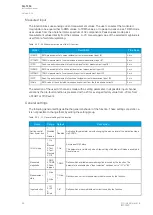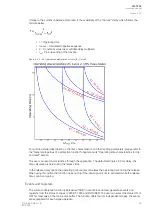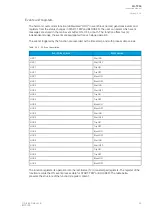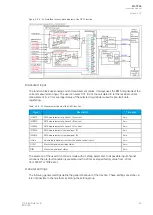
5.3.5 Harmonic overcurrent protection (Ih>; 50H/51H/68H)
The harmonic overcurrent function is used for non-directional instant and time-delayed overcurrent
detection and clearing. The number of stages in the function depends on the relay model. The function
constantly measures the selected harmonic component of the selected measurement channels, the
value being either absolute value or relative to the RMS value. The blocking signal and the setting
group selection control the operating characteristics of the function during normal operation, i.e. the
user or user-defined logic can change function parameters while the function is running.
The non-directional harmonic overcurrent function uses a total of eight (8) separate setting groups
which can be selected from one common source.
The function can operate on instant or time-delayed mode. Either START or TRIP signal can be used
when the instant mode is selected to block other protection stages. In time-delayed mode the
operation can be selected between definite time (DT) mode and inverse definite minimum time (IDMT)
mode. The START signal can be used to block other stages; if the situation lasts longer, the TRIP signal
can be used on other actions as time-delayed.The IDMT operation supports both IEC and ANSI
standard time delays as well as custom parameters.
The operational logic consists of the following:
• input magnitude selection
• input magnitude processing
• saturation check
• threshold comparator
• block signal check
• time delay characteristics
• output processing.
The basic design of the protection function is the three-pole operation.
The inputs of the function are the following:
• operating mode selections
• setting parameters
• digital inputs and logic signals
• measured and pre-processed current magnitudes.
The function's outputs are START, TRIP and BLOCKED signals which can be used for direct I/O
controlling and user logic programming. The function generates general time-stamped ON/OFF events
to the common event buffer from each of the three (3) output signals. In the instant operating mode the
function outputs START and TRIP events simultaneously with an equivalent time stamp. The time stamp
resolution is 1 ms. The function also provides a resettable cumulative counter for the START, TRIP and
BLOCKED events.
The following figure presents a simplified function block diagram of the non-directional harmonic
overcurrent function.
A
AQ
Q-T256
-T256
Instruction manual
Version: 2.06
© Arcteq Relays Ltd
IM00028
57
Содержание AQ-T256
Страница 1: ...AQ T256 Transformer protection IED Instruction manual...
Страница 2: ......
Страница 264: ...Figure 7 3 120 Example block scheme A AQ Q T256 T256 Instruction manual Version 2 06 262 Arcteq Relays Ltd IM00028...
Страница 284: ...Figure 8 13 141 Device installation A AQ Q T256 T256 Instruction manual Version 2 06 282 Arcteq Relays Ltd IM00028...













































